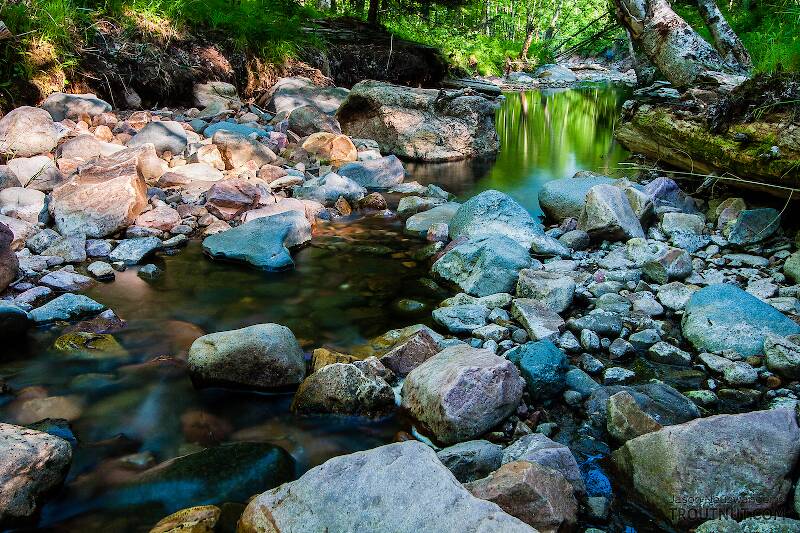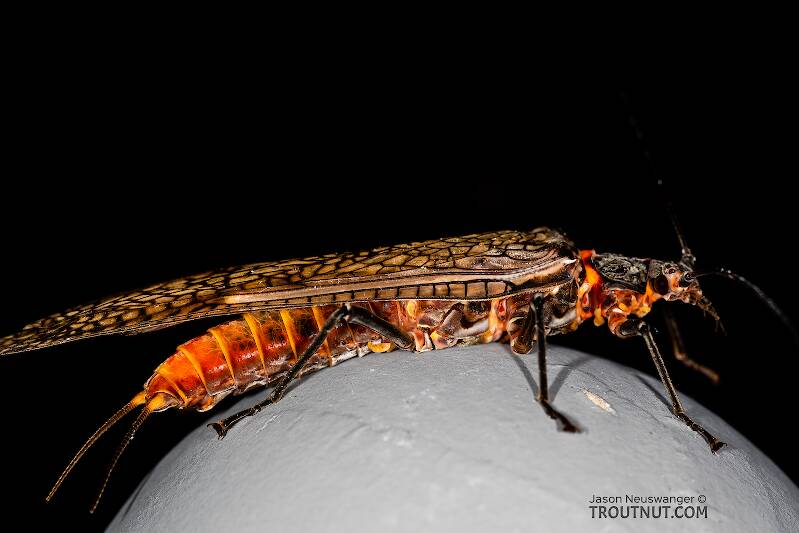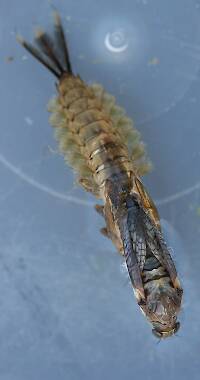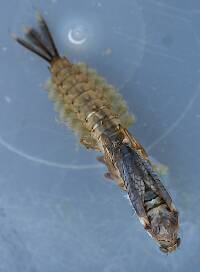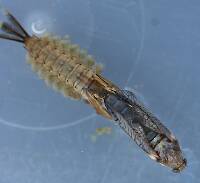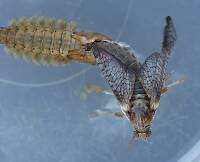
Hex Mayflies
Hexagenia limbata
The famous nocturnal Hex hatch of the Midwest (and a few other lucky locations) stirs to the surface mythically large brown trout that only touch streamers for the rest of the year.
Featured on the forum

This specimen keys pretty easily to Onocosmoecus, and it closely resembles a specimen from Alaska which caddis expert Dave Ruiter recognized as this genus. As with that specimen, the only species in the genus documented in this area is Onocosmoecus unicolor, but Dave suggested for that specimen that there might be multiple not-yet-distinguished species under the unicolor umbrella and it would be best to stick with the genus-level ID. I'm doing the same for this one.

Troutnut is a project started in 2003 by salmonid ecologist Jason "Troutnut" Neuswanger to help anglers and
fly tyers unabashedly embrace the entomological side of the sport. Learn more about Troutnut or
support the project for an enhanced experience here.
This topic is about the Stonefly Species Pteronarcys californica
This is the West's most legendary hatch. Anglers from all over the world make pilgrimages to the region's rivers in the hope of catching large trout surface feeding on these giant insects. Those fortunate enough to hit it right will have an awe-inspiring experience, regardless of their fishing luck.In cycles of plenty their numbers are truly astounding. They make up a large percentage of the biomass and this large lumbering grazer has had its niche likened to the huge herds of bison that once roamed the plains and foothills their rivers flow through. The hatch progresses upriver quickly, with adults being in the air or on the water for a given stretch only a few days or so. For reasons not fully understood, the nymphs prefer certain locations over others for "staging" prior to the hatch. An angler can stand on shore and notice very few of them while 50 yards up or down the rocks and bushes can be crawling. Competent guides and astute locals are aware of these locations and often fish them "in front of the hatch" for spectacular nymph fishing. An added bonus is they are also "in front of the crowds." Visiting anglers would do well to fish upriver of the latest angling reports. Fishing water based on "yesterday's news" often leads to seeing more anglers than salmonflies.
Example specimens
Troutnut on Jul 30, 2006July 30th, 2006, 11:04 am EDT
I don't have many reliable sources about this species, so it'd be great if you western fishermen could read over the article and make sure I haven't said anything stupid or omitted anything important. I'll be happy to incorporate any additions you have.
Jason Neuswanger, Ph.D.
Troutnut and salmonid ecologist
Troutnut and salmonid ecologist
Jim40 on Apr 4, 2007April 4th, 2007, 10:03 pm EDT
Hi Jason,
Salmon flies in my part of the world, southern BC, emerge generally in April and provide excellent sport for a relatively brief time.
I've written a little bit about them on my website. Although my photos are archaic compared to yours, you can check out my article on salmon flies, pteronarcys californica, at www.fly-fishing-british-columbia.com
and click on entomology.
Great site,
Jim
Salmon flies in my part of the world, southern BC, emerge generally in April and provide excellent sport for a relatively brief time.
I've written a little bit about them on my website. Although my photos are archaic compared to yours, you can check out my article on salmon flies, pteronarcys californica, at www.fly-fishing-british-columbia.com
and click on entomology.
Great site,
Jim
Rstrouts
Posts: 1
Posts: 1
Rstrouts on Jun 2, 2007June 2nd, 2007, 7:48 am EDT
Here in Colorado, the Salmonfly hatch occurs on the Colorado River starting in late May for 2-3 weeks after runoff has begun (starts around the first or second week of May) at elevations of 7600 feet (Parshall) and a bit higher. The females are bigger (around 2") than the males (around 1 1/2") and have a black egg sack. They fly in varying numbers during the day when the water temperature is in the early to mid 50's and are most active from around duske to dawn. I have seen them mating and holding onto the willows/grass/etc at or near shore as the willows are in their budding stage.
Although awkward, if they fall into the water, probably as the female bombardiers her eggs from the air (as seen in "Big Sky Bears" on Animal Planet or Discovery Channel), I have seen them make their way back to shore. I have also seen them ole trouties snatch them as they flop towards shore. Trout really key in on those flop flop flopping wings! Put an imitation fly next to a natural moving downstream and they take the natural every time because of the flopping wing motion!
Although I understand them to lay eggs while in the water, I have not seen this (nor have I personally seen them drop eggs from the air, just on the tv show).
Although awkward, if they fall into the water, probably as the female bombardiers her eggs from the air (as seen in "Big Sky Bears" on Animal Planet or Discovery Channel), I have seen them make their way back to shore. I have also seen them ole trouties snatch them as they flop towards shore. Trout really key in on those flop flop flopping wings! Put an imitation fly next to a natural moving downstream and they take the natural every time because of the flopping wing motion!
Although I understand them to lay eggs while in the water, I have not seen this (nor have I personally seen them drop eggs from the air, just on the tv show).
Invicta on Jun 3, 2007June 3rd, 2007, 3:01 pm EDT
Jason,
I agree with everyone's comments. I would only add that at those times I have been fortunate enough to be in a location having a good population of fish, and good water flow, the nymph fishing during the last two weeks leading up the salmon fly hatch has consistently produced the best fly fishing for me over the years. During that time the mature nymphs are migrating towards shore and the trout know it.
John
I agree with everyone's comments. I would only add that at those times I have been fortunate enough to be in a location having a good population of fish, and good water flow, the nymph fishing during the last two weeks leading up the salmon fly hatch has consistently produced the best fly fishing for me over the years. During that time the mature nymphs are migrating towards shore and the trout know it.
John
Aaron7_8 on Apr 25, 2008April 25th, 2008, 1:43 pm EDT
I would agree with Invicta last summer I was fishing/camping Rock Creek in June, and the salmon fly were so thick after a thunderstorm I thought it was snow. However the fish were so full of nymphs that it was rare to see a rise out of the fish.
Willamette
Posts: 1
Posts: 1
Willamette on Feb 18, 2009February 18th, 2009, 4:06 am EST
Here in Western Oregon the Salmon Fly hatch occurs quite a bit earlier than some of the higher altitude waters. I saw my first salmon fly of 2009 yesterday (2-17). Typically I see salmon flies through April with the majority of activity going on in March. These observations are from the upper willamette drainage (Mckenzie and Middle Fork Willamette rivers). The hatch here is much less pronounced than those on the east side of the Cascades and is not heavily fished. That said fish do take these bugs. I have also noticed that these West-Cascades salmonflies are typically very large, that is, larger than those on Eastern Oregon Streams.
Aaron7_8 on Feb 21, 2009February 21st, 2009, 2:51 am EST
It also depends on if it is just salmon flies you are looking for. In the waters I fish they have three different fishable stone fly hatches. The skwala hatch which are real dark colored to alomost an olive under belly usually about an inch long these come off first. Then we have the salmon fly which usually come off about the time of heaviest runoff, depending on the year. Then the golden stone that come off about the end of the salmon fly hatch and goes for three to four weeks after.
Chipper
Posts: 1
Posts: 1
Chipper on Jun 4, 2016June 4th, 2016, 7:55 pm EDT
I collected one of these yesterday (6/3/2016) on the Pecos River upstream from Terrero, New Mexico, elevation 7720 ft. Size is about 1.5 inches; Color is black/dark brown over orange. Seems the stoneflies are recovering from the stream scouring resulting from fires three years ago. The hatch should run 2 to 3 weeks.
Quick Reply
Related Discussions
Topic
Replies
Last Reply
4
Sep 4, 2012
by Entoman
by Entoman
3
May 21, 2012
by Entoman
by Entoman
8
Aug 23, 2016
by PaulRoberts
by PaulRoberts

